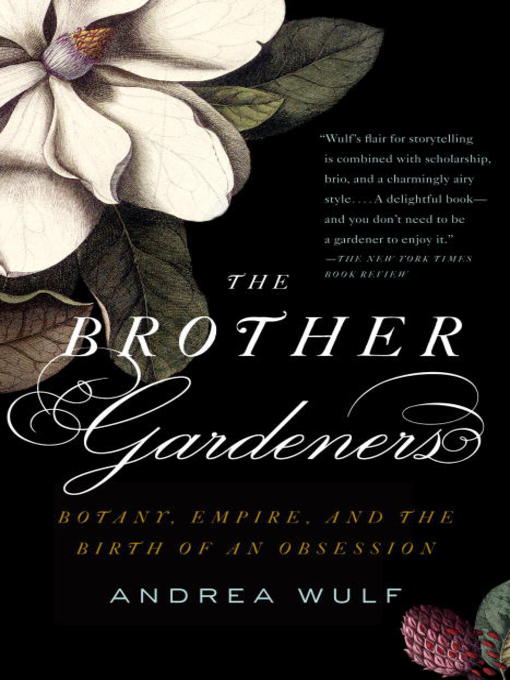
The Brother Gardeners
کتاب های مرتبط
- اطلاعات
- نقد و بررسی
- دیدگاه کاربران
نقد و بررسی

March 16, 2009
Wulf, a German-born journalist, wonderfully conveys the allure and cultural importance of the garden. Spanning nearly 100 years and several continents, Wulf begins her cultural investigation with the creation of the first manmade hybrid by devout Christian gardener Thomas Fairchild, who spent the rest of his life racked with guilt for the blasphemous act. She also introduces egomaniacal Swedish botanist Carl Linnaeus, who scandalized British society with his sexual system of classification; his book was banned by the Vatican. There is New World farmer John Bartram, who braved storms and steep mountains to discover new plants and send them back to his customers in England, hungry for exotic vegetation from America. As Wulf fills her readily accessible book with adventures aboard Captain Cook's ship, petty rivalries and outsized personalities, she provides an entertaining account of kooky botanists traveling the world and explores how gardening neutralized class lines, how horticulture and botany brought wealth and power, and how the English garden had a profound impact on modern landscape gardening, elevating the humble pursuit into the highest art.

February 15, 2009
British journalist Wulf (co-author: This Other Eden: Seven Great Gardens and 300 Years of English History, 2005) explores into the personalities that spurred the evolution of the 18th-century English garden.
Renaissance and baroque gardens on the European continent were characterized by smooth lawns, clipped hedges and topiary in a formal, geometrical structure, writes the author. When Thomas Fairchild, already famed for his luxuriant nursery outside of London, developed the first hybrid in 1716, he"set in motion a chain of events so momentous that in time no gardener would ever think about plants in the same way again." Wulf loosely follows these developments in smart, stylish prose without delving very deeply."Fairchild's mule," a cross between sweet William and a carnation, proved that plants reproduced sexually, an incendiary notion that Swedish botanist Carl Linnaeus underscored in his binomial nomenclature. This encouraged gardeners to meddle empirically in their own garden plots, just as Philip Miller's enormously accessible Gardeners Dictionary (1731), a catalogue of all plants then in cultivation in Britain, transformed gardening from an aristocratic preserve into the passionate pursuit of amateurs. Profoundly influenced by Miller's dictionary, London cloth merchant Peter Collinson began importing seeds and plantings from the North American colonies, specifically from Pennsylvania, with the help of Philadelphia farmer John Bartram. These floral dispatches, much desired because their hardiness precluded the need for hothouses, continued for more than four decades and helped make the English garden a natural-growing perennial marvel. Another contributor to this sea change was the treasure of botanical specimens brought back from Captain Cook's South Seas expedition, organized and bankrolled by celebrated botanist Joseph Banks, who was elected president of the Royal Society in 1778. Banks' economic use of such plants as cotton and the Indian gum tree propelled British industry, but Wulf skirts this crucial subject. She also gives scant attention to the idea of the English garden as an Enlightenment ideal.
An ornamental study, frustratingly lacking in contextual cultivation.
(COPYRIGHT (2009) KIRKUS REVIEWS/NIELSEN BUSINESS MEDIA, INC. ALL RIGHTS RESERVED.)

June 1, 2009
A garden will never look quite the same after you've read this book on the 18th-century British botanists who exploited the colonial system to acquire thousands of previously unknown plant species. Wulf argues that their imports vastly increased the blooming season and variety of English gardens, enabling gardeners to create the naturalistic "English" gardens coming into fashion after the geometry of the previous century. The London merchant (and backyard gardener) Peter Collinson persuaded Philadelphia's John Bartram to make plant-collecting treks through the wilderness, and this results in the introduction to British gardens of such mainstays of the modern border as azalea, mountain laurel, paper birch, and wisteria. Bartram supplied seeds to propagate North American varieties of oak, pine, hemlock, and cedar across the ocean. New species also appeared from Australia and Asia. Ships circumnavigated the globe to collect and classify new plants (including an ill-fated voyage captained by William Bligh). The brother gardeners resisted (but eventually gave way to) the novel system invented by obstreperous Swedish botanist Carl Linnaeus to classify the confusing array of new discoveries. Verdict Wulf's book will be of interest to anyone with a garden, even if it's on a windowsill.Stewart Desmond, New York
Copyright 2009 Library Journal, LLC Used with permission.

March 15, 2009
It is impossible today to stroll through a garden center or read a seed catalog without feeling the influence of six eighteenth-century men whose unbridled enthusiasm for the natural world revolutionized the way people would forever after relate to plants and gardening. In one of those mind-boggling cosmic confluences of people, place, and time, Joseph Banks, John Bartram, Peter Collinson, Carl Linnaeus, Philip Miller, and Daniel Solander were independently pursuing individual passions for new garden plants and botanical knowledge, a mutual obsession that eventually brought them into contact with each other. As Bartram and Collinson traded plant material between America and England, Banks and Solander discovered new species in the unexplored South Pacific, while Linnaeus and Miller established methods of identifying and cataloging the world's botanical riches. With the deft insight of a seasoned biographer, Wulf illuminates their singular and combined efforts in a dazzling narrative that reveals the personal appreciation and professional animosity that fueled this halcyon period in horticultural history.(Reprinted with permission of Booklist, copyright 2009, American Library Association.)

























دیدگاه کاربران